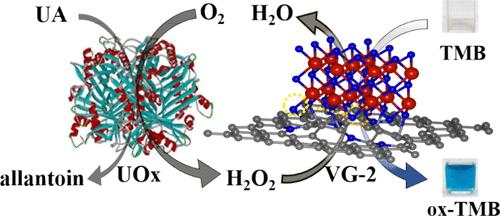共价偶联调控的氧化石墨烯/VN纳米复合材料使氮缺陷显著提高过氧化物酶样催化效率,用于尿酸超灵敏比色测定
IF 6.7
1区 化学
Q1 CHEMISTRY, ANALYTICAL
引用次数: 0
摘要
合理设计优良的纳米酶并了解其作用机制仍然是一个挑战。本文报道了一种易于共价偶联调节的氮缺陷,可显著提高过氧化物酶(POD)样活性。通过碳氮键在氧化石墨烯(GO)表面生长氮化钒(VN)纳米颗粒,形成VN/rGO纳米复合材料。初始增加的氧化石墨烯量能够形成C-N键,从而显著提高pod类活性。然而,随着氧化石墨烯用量的增加,氮缺陷减少,主要形成V2O3。含20 wt %氧化石墨烯(VG-2)的富缺陷VN/rGO纳米复合材料表现出最佳的催化效率(Vmax/Km = 0.0187 s-1),是天然辣根过氧化物酶的778倍。理论计算和结构表征表明,富n缺陷源于具有富电子结构的VN与rGO的共价结合,阻碍了VN的团聚,从而大大降低了催化反应速率决定步骤的能垒。最后,将尿酸氧化酶与VG-2作为酶级联,建立了尿酸(尿酸是肾功能或痛风发作的指标之一)的超灵敏选择性比色检测方法,线性检测范围为1 ~ 100 μM和0.1 ~ 2.5 mM,检出限为0.24 μM UA (S/N = 3),适用于人血清样品中尿酸的检测。这项工作可以激发更有效的见解,通过共价偶联设计其他健壮的纳米酶,用于各种生化分析和生物催化应用。本文章由计算机程序翻译,如有差异,请以英文原文为准。

Covalent Coupling-Regulated rGO/VN Nanocomposite Enabling Nitrogen Defects to Remarkably Boost the Peroxidase-Like Catalytic Efficiency for the Ultrasensitive Colorimetric Assay of Uric Acid
It remains challenging to rationally design superior nanozymes and understand the underlying mechanism. Herein, a facile covalent coupling-modulated nitrogen defect is reported for significantly boosting peroxidase (POD)-like activity. Vanadium nitride (VN) nanoparticles are grown on graphene oxide (GO) via C–N bonding to form VN/rGO nanocomposites by varying with the VOx/GO ratio. The initial increasing GO amount enables formation of the C–N bond, dramatically boosting POD-like activity. Nevertheless, with a higher GO amount, the nitrogen defects decrease due to forming mainly V2O3. The defect-rich VN/rGO nanocomposite with 20 wt % GO (VG-2) exhibits the best catalytic efficiency (Vmax/Km = 0.0187 s–1), which is 778-fold higher than that of natural horseradish peroxidase. Theoretical calculations and structure characterization reveal that the rich-N defects originate from VN covalent binding onto rGO with an rich-electron structure, impeding VN agglomeration, which greatly reduces the energy barrier of the rate-determining step of the catalytic reaction. Finally, coupling urate oxidase with VG-2 as an enzyme cascade, an ultrasensitive and selective colorimetric detection was developed for uric acid (UA), one of the indicators of kidney function or gout attacks, with a linear detection ranging 1–100 μM and 0.1–2.5 mM with a limit of detection of 0.24 μM UA (S/N = 3). The proposed method was applicable to detecting UA in human serum samples satisfactorily. This work could inspire more effective insights into designing other robust nanozymes through covalent coupling for a variety of biochemical analysis and biocatalysis applications.
求助全文
通过发布文献求助,成功后即可免费获取论文全文。
去求助
来源期刊

Analytical Chemistry
化学-分析化学
CiteScore
12.10
自引率
12.20%
发文量
1949
审稿时长
1.4 months
期刊介绍:
Analytical Chemistry, a peer-reviewed research journal, focuses on disseminating new and original knowledge across all branches of analytical chemistry. Fundamental articles may explore general principles of chemical measurement science and need not directly address existing or potential analytical methodology. They can be entirely theoretical or report experimental results. Contributions may cover various phases of analytical operations, including sampling, bioanalysis, electrochemistry, mass spectrometry, microscale and nanoscale systems, environmental analysis, separations, spectroscopy, chemical reactions and selectivity, instrumentation, imaging, surface analysis, and data processing. Papers discussing known analytical methods should present a significant, original application of the method, a notable improvement, or results on an important analyte.
 求助内容:
求助内容: 应助结果提醒方式:
应助结果提醒方式:


